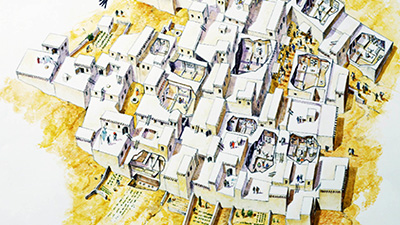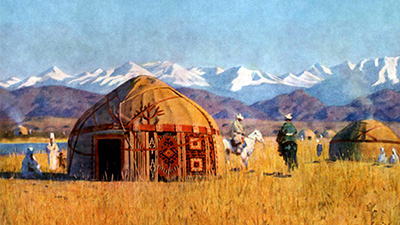Foragers and Village Networks
Teacher Resources
Driving Question: How did early villages depend on other villages, foragers, and pastoralists?
Early farming villages may have been small, but they were far from isolated. Discover how these communities connected through networks—and how they interacted with outsiders such as foragers, herders, and nomads.
Learning Objectives:
- Understand how village networks expanded into new forms of communities.
- Evaluate how villages interacted with each other and with groups like foragers, pastoralists, and nomads.
- Use claim-testing skills to evaluate evidence about early village networks.
Vocab Terms:
- division of labor
- inequality
- nomadic
- steppe
- urban
Opener: Foragers and Village Networks
To teach this lesson step, refer to page 2 of the Lesson 3.2 Teaching Guide.
As you prepare to learn about how different types of ancient communities interacted, use this activity to think about how they might react to different types of pressures.
The First Villages
To teach this lesson step, refer to page 3 of the Lesson 3.2 Teaching Guide.
Need a good poster for your classroom? Check out these claim-testing posters.
Before cities and large states, there were small villages. What can life in those small communities tell us about who we are now? Practice evaluating the evidence with the activity, then put those skills to use as you read the article.
-
Guiding Questions
-
Before you read
Preview the questions below, and then skim the article. Be sure to look at the section headings and any images.
While you read
Look for answers to these questions:
- How was life in early farming villages different from life in hunter-gatherer communities?
- What do we know about women’s lives in early farming villages?
- What are some examples of trade between villages?
- How did changes in production and distribution affect communities?
- In what ways did village networks affect the population of villages, towns, and cities?
After you read
Respond to this question: What do you think are some of the limitations of archaeological evidence?
What Is Civilization?
To teach this lesson step, refer to page 4 of the Lesson 3.2 Teaching Guide.
This would be a great time to use the Three-Step Reading Tool!
Not everyone took up farming immediately. For thousands of years, nomads, pastoralists, farmers, and foragers all lived alongside each other, connecting, fighting, and trading.
-
Guiding Questions
-
Before you read
Preview the questions below, and then skim the article. Be sure to look at the section headings and any images.
While you read
Look for answers to these questions:
- In what ways was farming “uneven”?
- What was central to nomadic pastoralists’ way of life? Why?
- How did different kinds of food production affect community structures?
- What networks were pastoralists, nomads, and foragers a part of?
- What are some advantages that nomadic communities had over settled communities?
After you read
Respond to this question: How does this article challenge the idea that people were foragers first and later became farmers?
Closer: Foragers and Village Networks
To teach this lesson step, refer to page 6 of the Lesson 3.2 Teaching Guide.
Reading primary sources can help you deepen your understanding of how different forms of communities interacted during this period.
Reviewing for Analysis and Evidence
To teach this lesson step, refer to page 6 of the Lesson 3.2 Teaching Guide.
Providing solid evidence and analyzing it is crucial for building a strong written argument. Look for these elements in a sample student essay.






